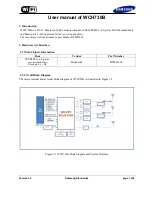
Introduction
These devices is WiFi6,
802.11 a/b/g/n/ax, 4x4, 20MHz/40MHz/80 MHz/160MHz,
support straddle channel (ch 138, ch142, ch144)
FEDERAL COMMUNICATION COMMISSION INTERFERENCE STATEMENT
This equipment has been tested and found to comply with the limits for a Class B digital device, pursuant to Part 15 of
the FCC Rules. These limits are designed to provide reasonable protection against harmful interference in a residential
installation. This equipment generates, uses and can radiate radio frequency energy and, if not installed and used in
accordance with the instructions, may cause harmful interference to radio communications. However, there is no
guarantee that interference will not occur in a particular installation. If this equipment does cause harmful
interference to radio or television reception, which can be determined by turning the equipment off and on, the user
is encouraged to try to correct the interference by one of the following measures:
• Reorient or relocate the receiving antenna.
• Connect the equipment into an outlet on a circuit different from that to which the receiver is connected.
• Increase the separation between the equipment and receiver.
• Consult the dealer or an experienced radio/TV technician for help.
Important Information about
the Sagemcom “F5380”:
Installation and Safe Usage Instructions:
1. Place the extender in a vertical orientation on a flat surface.
2. Connect the manufacturer supplied AC to DC power adapter. The F5380 extender requires the use of a 12VDC, 3.5A
power adapter. Only use a manufacturer supplied and approved power adapter and Ethernet cable.
3. Connect the
“F5380” to the AC Mains in accordance with the installation instructions in this booklet, and the markings
on the identification label (voltage, current, and frequency of electricity network).
4. Connect the Ethernet cable (provided) to
the RJ45 port labeled “LAN” on one end and to the Internet access device
provided by your ISP on the other end.
5. For connection of a computer with an Ethernet cable use one of the RJ45 ports on the product marked "1", "2". Then
connect the other end of the Ethernet Cable to the Ethernet port of a computer. Repeat as necessary with the other
available Ethernet ports.
Summary of Contents for F5380
Page 1: ...User Guide for F5380...






















